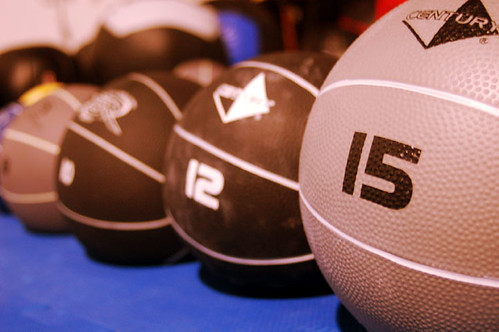We've recently added medicine balls to our equipment at the dojo; they are fantastic for building core strength and stability, and building strength. As we've started running open sessions for adults who would like to train independently, we thought we'd give you some ideas of how you can add this equipment into your workout.
Chops
This is essentially using the medicine ball the same way that you'd use a kettlebell. Stand with your feet slightly further than shoulder width apart, and hold the ball with both hands, with your arms straight and the ball at chest height. Lower the ball and bend your knees at the same time so that you end up in squat position with the ball slightly further back than your feet. Then bring the ball back to chest height while straightening your legs. Repeat.
Diagonal Chops
The same as chops, but instead of moving from the chest to between your legs, you move the ball from just above your right shoulder to just outside your left knee (and vice versa). This is great for your obliques.
Figure Eights
Begin with your feet shoulder-width apart and the ball at ear-height on your right. Bring the ball in an arch over your head and to your left, then down diagonally towards your right knee, and arch down to your left knee and up to your right ear again. Ensure that it's a smooth motion, and that the ball goes on the outside of your knees.
Circles
Like the figure eights, but instead of crossing over, you move in a circle.
Single Leg Chops
Like the chops detailed above, but standing on one leg. Make sure to alternate legs to get a balanced workout.
Squats
Stand with your feet slightly further than shoulder-width apart and the ball at chest height, with your arms straight. Squat down - make sure that you keep your back straight, face forwards and keep your shins upright (as if you're sitting down on a chair). Once you've reached a 90 degree angle, start moving back up. Don't lock your knees out when you straighten your legs.
Squat Throw
Same as squat, but instead of keeping the ball at the chest-height, throw the ball up above your head when you bend your legs and catch it at the bottom. Keep your arms above your head when catching, and don't throw it too high up! Return to chest height as you straighten your legs.
Lunges
Stand with your feet shoulder-width apart with the ball at chest height (with your arms straight). Step one foot forwards and bend that leg until your knee is at 90 degrees, with your back foot facing forwards and knee moving towards the floor (don't actually rest it on the floor). As you're bending your knee, raise the ball above your head until your arms are straight up above your head. Reverse the movement to go back to start position, and repeat on the other leg.
Medicine Ball Push Up
Get into push up position with both hands resting on the medicine ball. Keep both hands on the medicine ball and bend your arms to lower yourself towards the ground as far as you can go. Hold there for a breath and exhale as you straighten your arms again. Ensure that it's a smooth, controlled movement. If this is your first time, you may want to keep your feet slightly further apart than usual for stability.
Two-Arm Wall Pass
Stand in front of the wall, about an arm's length away. Keep your feet shoulder-width apart and begin by holding the ball behind your head with both hands. Raise the ball over your head and forwards until it is against the wall, and move back behind your head. As always, ensure it's a smooth and controlled movement, and that your heels stay on the floor throughout the movement.
Thanks to Sean Walsh for the image.


















































